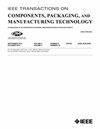Co-Design and ML-Based Optimization of Through-Via in Silicon and Glass Interposers for Electronic Packaging Applications
IF 2.3
3区 工程技术
Q2 ENGINEERING, ELECTRICAL & ELECTRONIC
IEEE Transactions on Components, Packaging and Manufacturing Technology
Pub Date : 2025-01-08
DOI:10.1109/TCPMT.2025.3527313
引用次数: 0
Abstract
Copper-filled via is a critical component of advanced electronic packaging technologies. Embedded in interposer substrate, vias provide enhanced electrical performance in 2.5-D and 3-D electronic packaging by allowing a smaller form factor. In addition to the electrical characteristics of an electronic package, its thermal and mechanical performance also depends on via geometry and the interposer material. This necessitates a co-design approach integrating thermal, mechanical, and electrical considerations. This article focuses on a numerical parametric study and multiobjective machine learning-based optimization of through-silicon via (TSV) and through-glass via (TGV). This study investigates the multidisciplinary effects of aspect ratio (AR) and pitch in the square and hexagonal array vias. Copper protrusion, thermal resistance, and electrical parasitics were used as the optimization performance indicators. An online artificial neural network (ANN) algorithm, as well as the conventional genetic algorithm (GA), was adopted to optimize the through-via designs. The parametric study demonstrated that glass substrates are more effective in reducing copper protrusion and mutual capacitance up to 47.5% and 67.6% compared to silicon. However, TSVs showed superior thermal performance. A higher AR helps minimize the copper protrusion for mechanical performance. Moreover, the thermal performance was enhanced by reducing the pitch and using hexagonal array vias. Regarding electrical performance, a high pitch and low AR are preferable to minimize electrical parasitics. Finally, a 61.3% decrease in the computation time was achieved by using an online ANN-based optimization scheme compared to GA, highlighting its potential in the optimization of high-fidelity complex electronic designs.求助全文
约1分钟内获得全文
求助全文
来源期刊

IEEE Transactions on Components, Packaging and Manufacturing Technology
ENGINEERING, MANUFACTURING-ENGINEERING, ELECTRICAL & ELECTRONIC
CiteScore
4.70
自引率
13.60%
发文量
203
审稿时长
3 months
期刊介绍:
IEEE Transactions on Components, Packaging, and Manufacturing Technology publishes research and application articles on modeling, design, building blocks, technical infrastructure, and analysis underpinning electronic, photonic and MEMS packaging, in addition to new developments in passive components, electrical contacts and connectors, thermal management, and device reliability; as well as the manufacture of electronics parts and assemblies, with broad coverage of design, factory modeling, assembly methods, quality, product robustness, and design-for-environment.
 求助内容:
求助内容: 应助结果提醒方式:
应助结果提醒方式:


